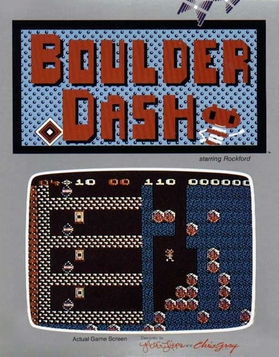
Boulder Dash is a 2D maze-puzzle video game released in 1984 by First Star Software for Atari 8-bit computers. It was created by Canadian developers Peter Liepa and Chris Gray. The player controls Rockford, who collects treasures while evading hazards.

Paperboy is an arcade action game developed and published by Atari Games, and released in 1985. The player takes the role of a paperboy who delivers a fictional newspaper called The Daily Sun along a street on his bicycle. The arcade version of the game featured bike handlebars as the controller.

Mercenary is a 3D action-adventure game written for the Atari 8-bit family and published by Novagen Software in 1985. It was converted to the Commodore 64, ZX Spectrum, Amstrad CPC, Atari ST, Amiga and Commodore 16/116/Plus/4 platforms. The game uses vector graphics renderings of vast, sparse environments and has open-ended gameplay. It was also released as Mercenary: Escape from Targ and Mercenary: A Flight Simulator Adventure.

Golden Axe is a side-scrolling hack-and-slash video game released by Sega for arcades in 1989, running on the Sega System 16B arcade hardware. Makoto Uchida was the lead designer of the game, and was also responsible for the creation of the previous year's Altered Beast. The game casts players as one of three warriors who must free the fantastical land of Yuria from the tyrannical rule of Death Adder, who wields the titular Golden Axe.
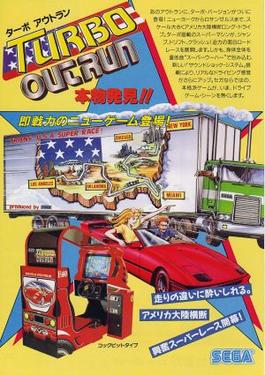
Turbo OutRun (ターボアウトラン) is a 1989 arcade racing game released by Sega. A follow-up to 1986's Out Run, it was released as a dedicated game, as well as an upgrade kit for the original Out Run board.

Skool Daze is a computer game released by Microsphere in 1984 for the ZX Spectrum and ported to the Commodore 64 the following year. It was written by David Reidy, with graphics designed by Keith Warrington. The game was commercially and critically successful, and praised for its original concept. It has since been regarded as one of the pioneers of the sandbox game genre.
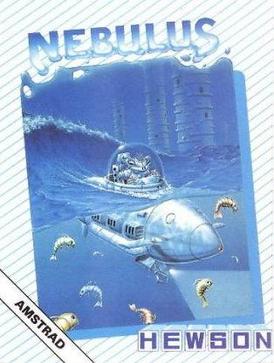
Nebulus is a platform game created by John M. Phillips and published by Hewson Consultants in the late 1980s for home computer systems. International releases and ports were known by various other names: Castelian, Kyorochan Land, Subline, and Tower Toppler.

Bomb Jack is a platform game published by Tehkan for arcades and later ported to home systems. The game was a commercial success for arcades and home computers. It was followed by several sequels: the console and computer game Mighty Bomb Jack, the arcade game Bomb Jack Twin, and Bomb Jack II which was licensed for home computers only.

Kwik Snax is an arcade style maze video game play developed by the Oliver Twins and was published in 1990 by Codemasters for the Amstrad CPC, Spectrum, Commodore 64, MS-DOS, and Amiga. It was the fifth game in the Dizzy series and is considered a sequel to Fast Food.
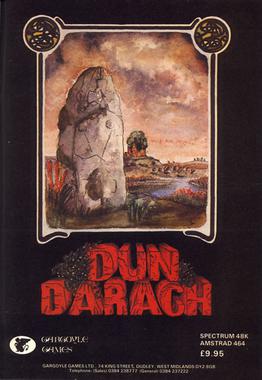
Dun Darach is an arcade adventure developed and published in 1985 by Gargoyle Games for the ZX Spectrum and Amstrad CPC computers. It is a prequel to the 1984 game Tir Na Nog. The plot has Celtic hero Cuchulainn on a search to find his companion Lóeg in the mysterious city of Dun Darach. Inspiration for the game came from the works of Fritz Leiber and Michael Moorcock.

Wonder Boy is a 1986 platform game published by Sega and developed by Escape. Originally designed for arcades, it was later ported to the SG-1000, Mark III/Master System and Game Gear video game consoles by Sega, and to the ZX Spectrum, Commodore 64 and Amstrad CPC home computers by Activision. The game is also known as Super Wonder Boy for its Sega Mark III release in Japan and Revenge of Drancon for its Game Gear release in North America. A high definition remake of the game, titled Wonder Boy Returns, was developed by CFK and released on Steam on October 12, 2016. Wonder Boy was rereleased in 2022 as part of Wonder Boy Collection for the Nintendo Switch and PlayStation 4 which includes its versions on arcade, Master System, SG-1000 and Game Gear.
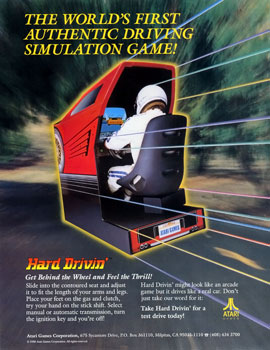
Hard Drivin' is a sim racing arcade video game developed by Atari Games in 1989. Players test drive a sports car on courses that emphasize stunts and speed. It features one of the first 3D polygon driving environments via a simulator cabinet with a haptic vibrating steering wheel and a custom rendering architecture.
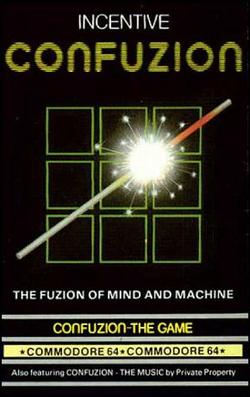
Confuzion is a puzzle game developed and published by Incentive Software for the ZX Spectrum, Commodore 64, BBC Micro, and Acorn Electron. The object is to guide a spark along a fuse wire. It is similar to the 1982 arcade game Loco-Motion.Confuzion was written by Paul Shirley who later wrote Spindizzy.
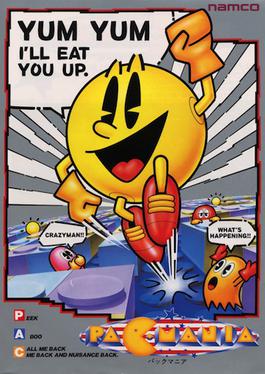
Pac-Mania is a cavalier perspective maze game that was developed and released by Namco for arcades in 1987. In the game, the player controls Pac-Man as he must eat all of the dots while avoiding the colored ghosts that chase him in the maze. Eating large flashing "Power Pellets" will allow Pac-Man to eat the ghosts for bonus points, which lasts for a short period of time. A new feature to this game allows Pac-Man to jump over the ghosts to evade capture. It is the ninth title in the Pac-Man video game series and was the last one developed for arcades up until the release of Pac-Man Arrangement in 1996. Development was directed by Pac-Man creator Toru Iwatani. It was licensed to Atari Games for release in North America.
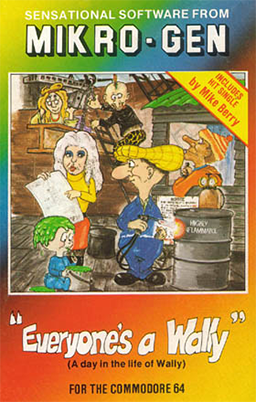
Everyone's a Wally is a British video game released in 1985 by Mikro-Gen for the ZX Spectrum, Amstrad CPC, and Commodore 64. The sequel to Pyjamarama, it features the same hero character, Wally Week, and uses an upgraded version of the same game engine.

Buggy Boy, known as Speed Buggy in North America, is an off-road racing game developed by Tatsumi and released for arcades in 1985. The cockpit version of the arcade cabinet has a panoramic three-screen display, a feature previously employed in TX-1, but with Buggy Boy having a larger cabinet. An upright, single-screen cabinet was released in 1986 under the name Buggy Boy Junior.
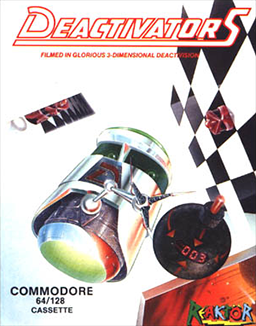
Deactivators is a 1986 puzzle video game designed by David Bishop and Chris Palmer, developed by Tigress Marketing and System Software, and published by Ariolasoft's action game imprint Reaktor. The player controls bomb disposal robots known as deactivators and must use them to deactivate bombs planted by terrorists in five research complexes. The concept for the game came from a brainstorming session between Bishop and Palmer; its design and development took five to six months to complete. It was released for the Amstrad CPC 464, Commodore 64, and ZX Spectrum platforms in October 1986.

Gary Lineker's Superstar Soccer is a computer game released in 1987 for the Amstrad CPC, Commodore 64 and ZX Spectrum, published by Gremlin Interactive in Europe, and by Mindscape as Superstar Soccer in the USA.

Human Killing Machine is a 2D fighting video game. The game was developed by British company Tiertex, who hired external team Blue Turtle to produce the graphics, and published by U.S. Gold, released in March 1989. It was touted as a sequel to Tiertex's home computer conversion of Street Fighter. It was released for 8-bit and 16-bit home computer formats.
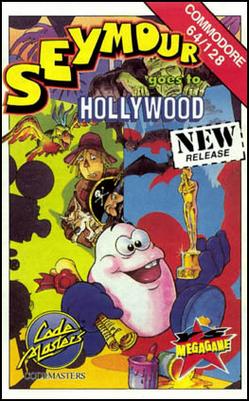
Seymour Goes to Hollywood, also known as Seymour at the Movies, is a platform and adventure game developed by Big Red Software and originally published in Europe by Codemasters in 1991. Players control Seymour, a small potato-like creature who wishes to be a film star. The film's script has been locked in a safe, meaning Seymour must solve puzzles by collecting and using objects scattered throughout the game in order to progress, ultimately retrieving the script and allowing filming to start.




















